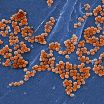(Press-News.org) CHAMPAIGN, Ill. -- When a large protein unfolds in transit through a cell, it slows down and can get stuck in traffic. Using a specialized microscope -- a sort of cellular traffic camera -- University of Illinois chemists now can watch the way the unfolded protein diffuses.
Studying the relationship between protein folding and transport could provide great insight into protein-misfolding diseases such as Alzheimer's and Huntington's. Chemistry professor Martin Gruebele and graduate students Minghao Guo and Hannah Gelman published their findings in the journal PLOS ONE.
"We're looking at the earliest stages of disease, the initial phases of transport of bad proteins," Gruebele said. In the past, he said, much research on Alzheimer's and similar disease focused on fibrils, large bundles of misfolded proteins that form in the brain.
"But now, we think the fibrils are just an end product that's left over when the cell dies, and the actual killing mechanism has to do with migration of the protein to specific places in the cell like the outer membrane," he said. "Understanding how these mechanisms work at a fundamental level is going to give people more handles on where to look to cure things."
Researchers have hypothesized that an unfolded protein moves more slowly through the cell, because it would be a big, stringy mess rather than a tightly wrapped package. The Illinois team devised a way to measure how diffusion slows down when a protein unfolds using a fluorescence microscope, then used three-dimensional diffusion models to connect the protein's unfolding to its motion.
The researchers found that the unfolded protein did indeed slow down, although its speed was not steady. It sometimes zoomed swiftly to a new location, and sometimes sat idling in one area, like a vehicle in stop-and-go rush-hour traffic. They were able to map out areas of the cell with different rates of diffusion, the cellular version of a speed limit.
The unfolded protein's slowdown is not only due to size, however. The researchers did additional experiments to prove that the unfolded protein stuck to other molecules in the cell. A class of molecules in the cell called chaperones have the job of binding to parts of proteins that come unfolded, and the researchers found that the unfolded protein interacted more with chaperones than did the properly folded protein. However, when high numbers of proteins unfold, the cell's systems can get overloaded and the chaperones can't handle them all.
"Looking at something like this can start to give people a handle on why something that seems relatively harmless in vitro sometimes can have such a large effect in the cell," Gelman said. "A change that makes a slightly less effective protein in the test tube can turn into a completely fatal mutation in the cell. First, the protein's role in the cell can no longer be fulfilled. Second, as more and more unfold, they can disrupt the function of the whole cell."
The researchers think that the unfolded protein is likely to stick to nonchaperone molecules, as well, causing other problems in the cell and disrupting the flow within a cell. They plan to use the specialized microscope to study other proteins and how unfolding affects their diffusion, to see if the properties they observed are universal or if each protein has its own response.
They also hope to use their method to watch how unfolded or misfolded proteins move to the cell's membrane, where they aggregate and create the problems seen in Alzheimer's and other diseases.
"There's a whole cascade of things," Gruebele said. "If you have a single car accident in the middle of nowhere, it's really only a problem for the owner. But if you have a single car that stops in the middle of the road on the freeway in Los Angeles, very soon the entire freeway is going to be backed up. What we're looking at is like the car stopping on the freeway. We're not worried yet about what happens to the line of cars an hour later - that's the fibril."
INFORMATION:
The National Science Foundation supported this work.
To reach Martin Gruebele, call 217-333-1624; email: gruebele@scs.illinois.edu.
The paper, "Coupled Protein Diffusion and Folding in the Cell," is available online at http://www.plosone.org/article/info%3Adoi%2F10.1371%2Fjournal.pone.0113040.
Irvine, Calif., Dec. 9, 2014 -- A learning technique that maximizes the brain's ability to make and store memories may help overcome cognitive issues seen in fragile X syndrome, a leading form of intellectual disability, according to UC Irvine neurobiologists.
Christine Gall, Gary Lynch and colleagues found that fragile X model mice trained in three short, repetitious episodes spaced one hour apart performed as well on memory tests as normal mice. These same fragile X rodents performed poorly on memory tests when trained in a single, prolonged session - which is a standard ...
A new study links ADHD and conduct disorder in young adolescents with increased alcohol and tobacco use. The Cincinnati Children's Hospital Medical Center study is among the first to assess such an association in this age group.
Conduct disorder is a behavioral and emotional disorder marked by aggressive, destructive or deceitful behavior.
The study is published in the journal Drug and Alcohol Dependence.
"Early onset of substance abuse is a significant public health concern," says William Brinkman, MD, a pediatrician at Cincinnati Children's Hospital Medical Center ...
INDIANAPOLIS -- As hospice for nursing home patients grows dramatically, a new study from the Regenstrief Institute and the Indiana University Center for Aging Research compares the characteristics of hospice patients in nursing homes with hospice patients living in the community. The study also provides details on how hospice patients move in and out of these two settings.
Longer lengths of hospice care, rising costs and concerns over possible duplication of services have led to increased scrutiny by policymakers of hospice patients living in nursing homes. Nursing ...
E-cigarettes appear to be less addictive than cigarettes for former smokers and this could help improve understanding of how various nicotine delivery devices lead to dependence, according to researchers.
"We found that e-cigarettes appear to be less addictive than tobacco cigarettes in a large sample of long-term users," said Jonathan Foulds, professor of public health sciences and psychiatry, Penn State College of Medicine.
The popularity of e-cigarettes, which typically deliver nicotine, propylene glycol, glycerin and flavorings through inhaled vapor, has increased ...
PHILADELPHIA -Researchers at Penn Medicine, in collaboration with a multi-center international team, have shown that a protease inhibitor, simeprevir, a once a day pill, along with interferon and ribavirin has proven as effective in treating chronic Hepatitis C virus infection (HCV) as telaprevir with interferon and ribavirin, the standard of care in developing countries. Further, simeprevir proved to be simpler for patients and had fewer adverse events. The complete study is now available online and is scheduled to publish in January 2015 in The Lancet Infectious Diseases. ...
BELLINGHAM, Washington, USA, and COLCHESTER, UK -- Swimmers looking to monitor and improve technique and patients striving to heal injured muscles now have a new light-based tool to help reach their goals. A research article by scientists at the University of Essex in Colchester and Artinis Medical Systems published today (5 December) in the Journal of Biomedical Optics (JBO) describes the first measurements of muscle oxygenation underwater and the development of the enabling technology.
The article, "Underwater near-infrared (NIR) spectroscopy measurements of muscle ...
Increases in excess fat adversely affect multiple cardiometabolic risk markers even in lean young adults according to a new study published this week in PLOS Medicine. The study by Peter Würtz from the University of Oulu, Finland, and colleagues suggests that, even within the range of body-mass index (BMI) considered to be healthy, there is no threshold below which a BMI increase does not adversely affect the metabolic profile of an individual.
Adiposity, or having excess body fat, is a growing global threat to public health. Compared to people with a lean body ...
December 9, 2014 -- Methicillin-resistant Staphylococcus aureus (MRSA) is a common cause of hospital-acquired infections, with the largest burden of infections occurring in under-resourced hospitals. While genome sequencing has previously been applied in well-resourced clinical settings to track the spread of MRSA, transmission dynamics in settings with more limited infection control is unknown. In a study published online today in Genome Research, researchers used genome sequencing to understand the spread of MRSA in a resource-limited hospital with high transmission rates.
Patients ...
SAN FRANCISCO (DECEMBER 9, 2014) -Common variations in four genes related to brain inflammation or cells' response to damage from oxidation may contribute to the problems with memory, learning and other cognitive functions seen in children treated for acute lymphoblastic leukemia (ALL), according to a study led by researchers from Boston Children's Hospital, The Children's Hospital at Montefiore, and Dana-Farber/Boston Children's Cancer and Blood Disorders Center.
The data, presented at the 56th annual meeting of the American Society of Hematology (abstract #856), suggest ...
A team of Massachusetts General Hospital (MGH) investigators has identified what may be a biomarker predicting the development of the dangerous systemic infection sepsis in patients with serious burns. In their report in the open-access journal PLOS ONE, the researchers describe finding that the motion through a microfluidic device of the white blood cells called neutrophils is significantly altered two to three days before sepsis develops, a finding that may provide a critically needed method for early diagnosis.
"Neutrophils are the major white blood cell protecting ...




